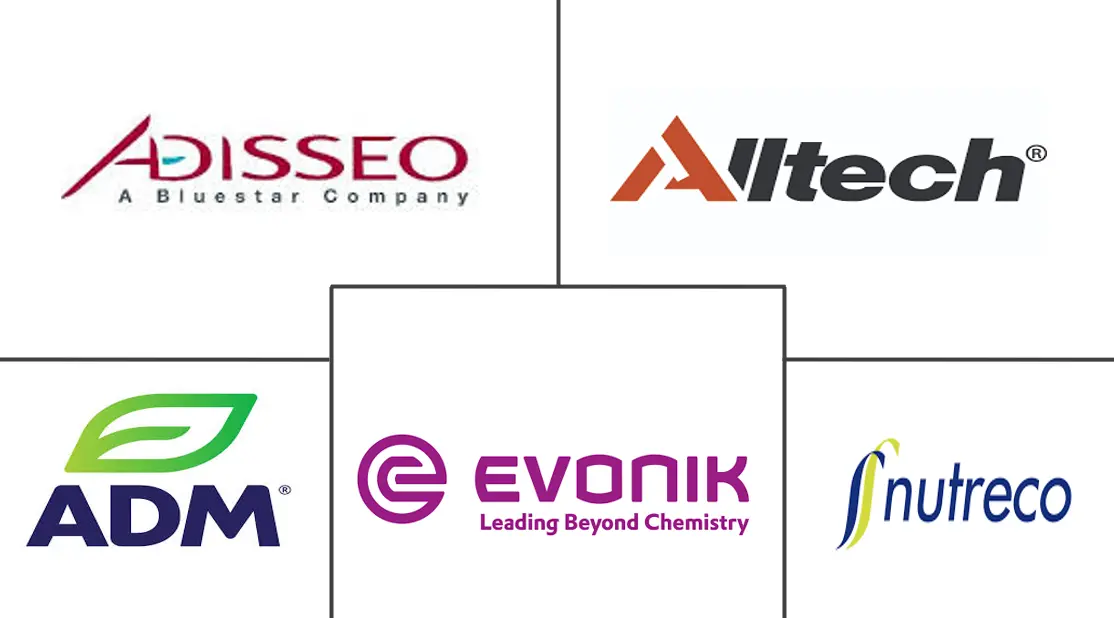India Feed Amino Acids Market Size and Share
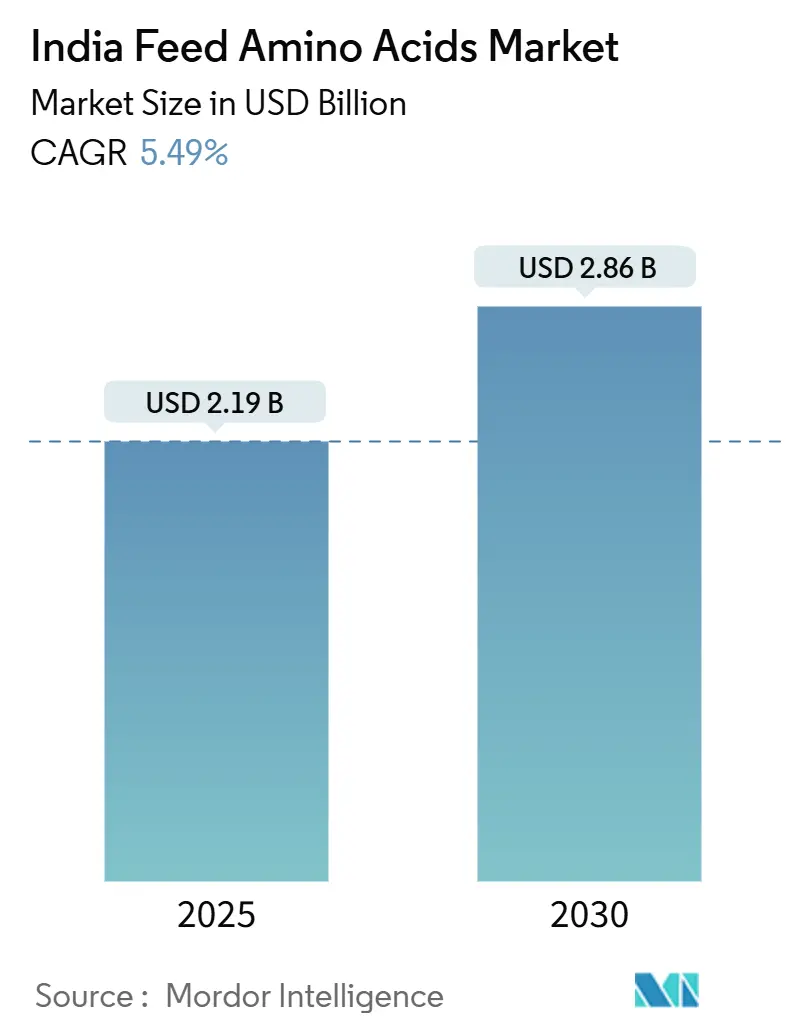
India Feed Amino Acids Market Analysis by Mordor Intelligence
The India feed amino acids market size stands at USD 2.19 billion in 2025 and is forecast to reach USD 2.86 billion by 2030, registering a 5.49% CAGR across the period. Rising household protein intake, rapid livestock industrialization, and government support for organized farming are steering sustained demand for precision nutrition additives. Poultry integrators have moved from crude protein formulas toward crystalline amino-acid–balanced diets that trim feed costs and shrink nitrogen output. In aquaculture, crop‐loss concerns and stricter residue limits motivate mills to fortify shrimp and fish rations with digestible methionine and lysine. Parallel capacity additions by global suppliers and Indian fermentation start-ups are building local supply resilience while price volatility in soymeal and corn prompts feed makers to substitute part of the protein matrix with targeted amino acids.
Key Report Takeaways
- By sub-additive, lysine led with 41.3% of the India feed amino acids market share in 2024, while methionine is advancing at a 5.7% CAGR through 2030.
- By animal, poultry accounted for 66.1% of the India feed amino acids market size in 2024 and is projected to expand at a 5.7% CAGR between 2025 and 2030.
India Feed Amino Acids Market Trends and Insights
Drivers Impact Analysis
| Driver | (~) % Impact on CAGR Forecast | Geographic Relevance | Impact Timeline |
|---|---|---|---|
| Rising poultry meat and egg consumption | +2.1% | Andhra Pradesh, Tamil Nadu, Maharashtra | Medium term (2-4 years) |
| Organized aquaculture feed-mill expansion | +1.8% | Coastal Andhra Pradesh, West Bengal, Odisha | Medium term (2-4 years) |
| Government subsidies and import policy relief | +1.4% | Nationwide, stronger in livestock-dense states | Short term (≤ 2 years) |
| Low-protein diet reformulation with crystalline amino acids | +1.6% | National, commercial feed mills | Long term (≥ 4 years) |
| Molasses-based domestic fermentation capacity build-out | +1.2% | Maharashtra, Uttar Pradesh, Karnataka | Long term (≥ 4 years) |
| Sulfur-balanced bio-digestate fertilizer demand | +0.9% | Poultry belts with high litter output | Long term (≥ 4 years) |
| Source: Mordor Intelligence | |||
Rising Poultry Meat and Egg Consumption
India produces around 118 billion eggs annually, with a rising affinity for egg consumption as a prominent protein source. Commercial broiler companies run phased feeding programs where synthetic lysine and DL-methionine are indispensable for hitting target feed-conversion ratios. The Food Safety and Standards Authority of India banned growth-promoter antibiotics such as colistin and chloramphenicol in April 2025, which pushed integrators to rely on amino-acid–driven performance gains [1]Source: Rashmi Minocha and Rajeshwari Sinha, “FSSAI bans use of antibiotics in production of food animals — here's what it means,” Down To Earth, downtoearth.org.in. Demand clusters in Tamil Nadu and Andhra Pradesh anchor dedicated distribution depots and on-farm technical service labs. With urban consumer poultry uptake rising at near 6% annually, the India feed amino acids market maintains a structural growth pillar rooted in this species.
Organized Aquaculture Feed-Mill Expansion
Indian feed mills produced an estimated 1.1-1.15 million metric tons of shrimp feed in 2024, following a dip from the previous cycle, yet long-term prospects stay bullish as exporters target low-antibiotic certification. High-density shrimp ponds require diets fortified with protected methionine to mitigate muscle necrosis and improve feed efficiency. Coastal Andhra Pradesh hosts more than 65 integrated processors that own hatcheries, feed plants, and farms, creating tight supply corridors for amino acid concentrates. Millers are adopting twin-screw extrusion lines that help embed crystalline amino-acid premixes for uniform pellet distribution. Research funded under ICAR (Indian Council of Agricultural Research) has mapped essential amino acid profiles for Indian major carp, guiding wider uptake across freshwater fish segments.
Government Subsidies and Import Policy Relief
The National Livestock Mission offers capital subsidies covering 33% of feed plant equipment, and the September 2025 GST rate cut from 18% to 5% on nutraceutical inputs lowered working capital tied up in amino acids. Intermittent exemptions on genetically modified soymeal imports moderate domestic protein-meal inflation, making crystalline amino acids comparatively economical[2]Source: Government of India, “GST Council Press Release on Rate Changes, September 2025,” gstcouncil.gov.in . Policy signals foster smaller feed mills’ willingness to trial low-protein diets, broadening the client pool for specialized suppliers.
Low-Protein Diet Reformulation with Crystalline Amino Acids
Formulating a 1-2 percentage-point lower crude-protein broiler ration saves roughly INR 1,200 (USD 14) per metric ton when soymeal trades above INR 55,000 (USD 660) per metric ton. The nutritional gap is bridged using feed-grade lysine, methionine, threonine, and tryptophan. Mills reports a 7-10% cut in nitrogen excretion, easing environmental compliance. Advances in rapid NIRS-based digestibility prediction let nutritionists fine-tune digestible amino acid matrices in minutes at the feed plant. Early-adopter mills such as Suguna and Godrej Agrovet document margin lift without compromising body-weight gain, validating this practice and locking in sustainable offtake for the India feed amino acids market.
Restraints Impact Analysis
| Restraint | (~) % Impact on CAGR Forecast | Geographic Relevance | Impact Timeline |
|---|---|---|---|
| Soymeal and corn price volatility | -1.5% | National, stronger in feed-deficit belts | Short term (≤ 2 years) |
| BIS (Bureau of Indian Standards) and FSSAI (Food Safety and Standards Authority of India) regulatory hurdles | -0.8% | Nationwide | Medium term (2-4 years) |
| Exposure to anti-dumping duties on imports | -1.1% | Import-dependent distributors | Short term (≤ 2 years) |
| Cold-chain gaps for liquid blends | -0.6% | Rural and peri-urban areas | Long term (≥ 4 years) |
| Source: Mordor Intelligence | |||
Soymeal and Corn Price Volatility
Feed-grade soymeal touched INR 66,000 (USD 792) per metric ton in mid-2024 before sliding below INR 46,000 (USD 552) by year-end, unsettling nutrient-cost planning in all species. During low-price windows, mills sometimes revert to protein-heavy recipes, diluting amino-acid inclusion. Conversely, sudden spikes squeeze cash flows, delaying new purchase contracts. Smaller mills seldom hedge futures or hold safety stocks, amplifying procurement shocks. This volatility weighs on predictable uptake trajectories and temporarily blunts the India feed amino acids market’s expansion momentum.
BIS (Bureau of Indian Standards) and FSSAI (Food Safety and Standards Authority of India) Regulatory Hurdles
Each new amino acid premix must clear dual registration with the Bureau of Indian Standards and separate product approvals under FSSAI (Food Safety and Standards Authority of India) feed additive norms, incurring laboratory costs nearing INR 1.3 million (USD 15,600) per SKU and cycle times of 6-12 months [3]Source: Ministry of Commerce and Industry, “Notification on Anti-Dumping Duty for Lysine Imports, 2021,” commerce.gov.in . Small importers lack the staffing to track shifting residue limits or label templates. Implementation of antibiotic restrictions also obliges validators to run extra residue analyses on premixed feeds, adding turnaround time. Compliance raises operating costs and can delay the launch of value-added formulations, slowing innovation diffusion within the India feed amino acids market.
Segment Analysis
By Sub-Additive: Methionine Drives Premium Formulations
Lysine dominates the sub-additive segment with 41.3% market share in 2024, reflecting its fundamental role as the first limiting amino acid in most plant-based feed formulations. Its widespread use across poultry, swine, and aquaculture applications makes it the cornerstone of amino acid supplementation programs. The development of molasses-based fermentation capacity in sugar-producing states like Maharashtra and Karnataka is creating opportunities for domestic lysine production, potentially reducing import dependence and improving supply chain resilience.
Methionine represents the fastest-growing segment at 5.7% CAGR through 2030, driven by expanding aquaculture operations and premium poultry formulations targeting improved meat quality and disease resistance. The amino acid's critical role in protein synthesis and immune function makes it particularly valuable in high-performance production systems. Regulatory compliance factors under FSSAI standards are driving demand for pharmaceutical-grade amino acids with enhanced purity specifications, particularly in export-oriented aquaculture operations.
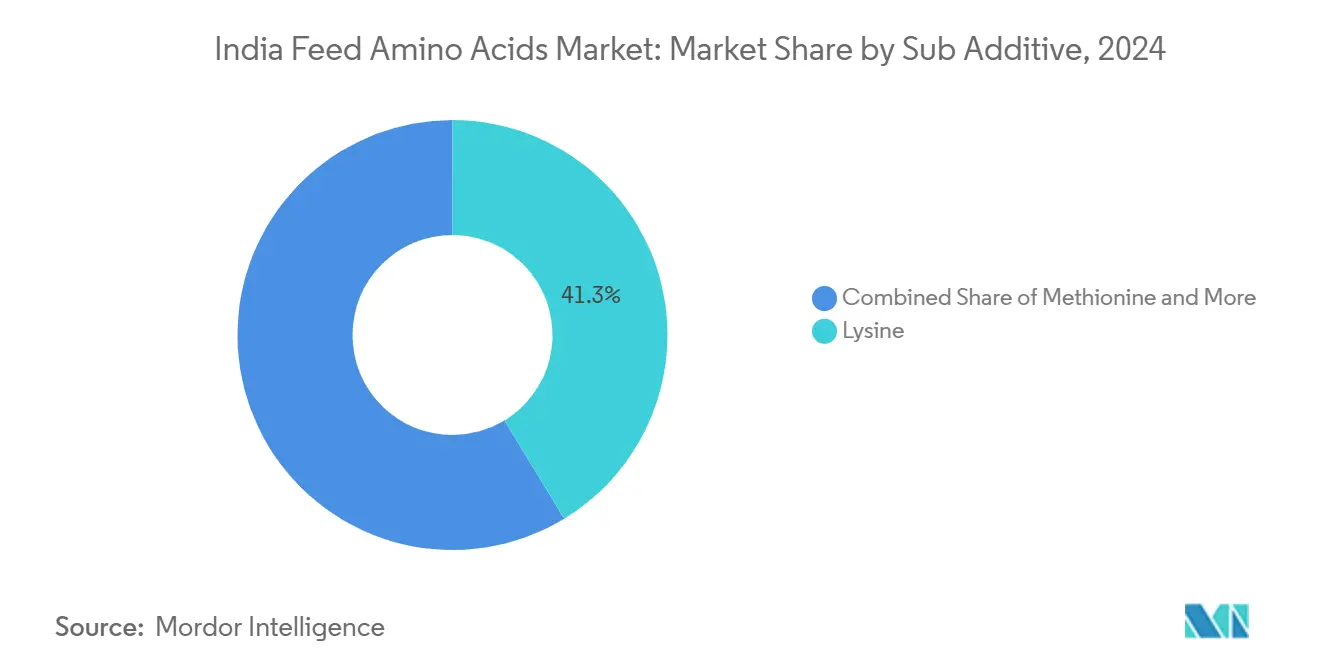
Note: Segment shares of all individual segments available upon report purchase
By Animal: Poultry Emerges Despite Challenges
Poultry holds the largest share at 66.1% of the Indian feed amino acids market in 2024 and is likely to grow at a CAGR of 5.7% through 2030. Integrators implement phase-feeding programs to reduce grow-out periods using consistent crystalline amino acid inputs. Broiler feed accounts for two-thirds of lysine consumption, while commercial layer operations use balanced methionine to maintain egg production. Breeder flocks represent a specialized segment for protected tryptophan usage related to fertility enhancement. The aquaculture segment, comprising shrimp and freshwater finfish, accounts for a modest share of amino acid consumption volume and generates an impressive share of market value due to higher inclusion rates and premium feed prices. The segment's growth is supported by increasing awareness of amino acid requirements in high-producing dairy cows and the development of rumen-protected amino acid products.
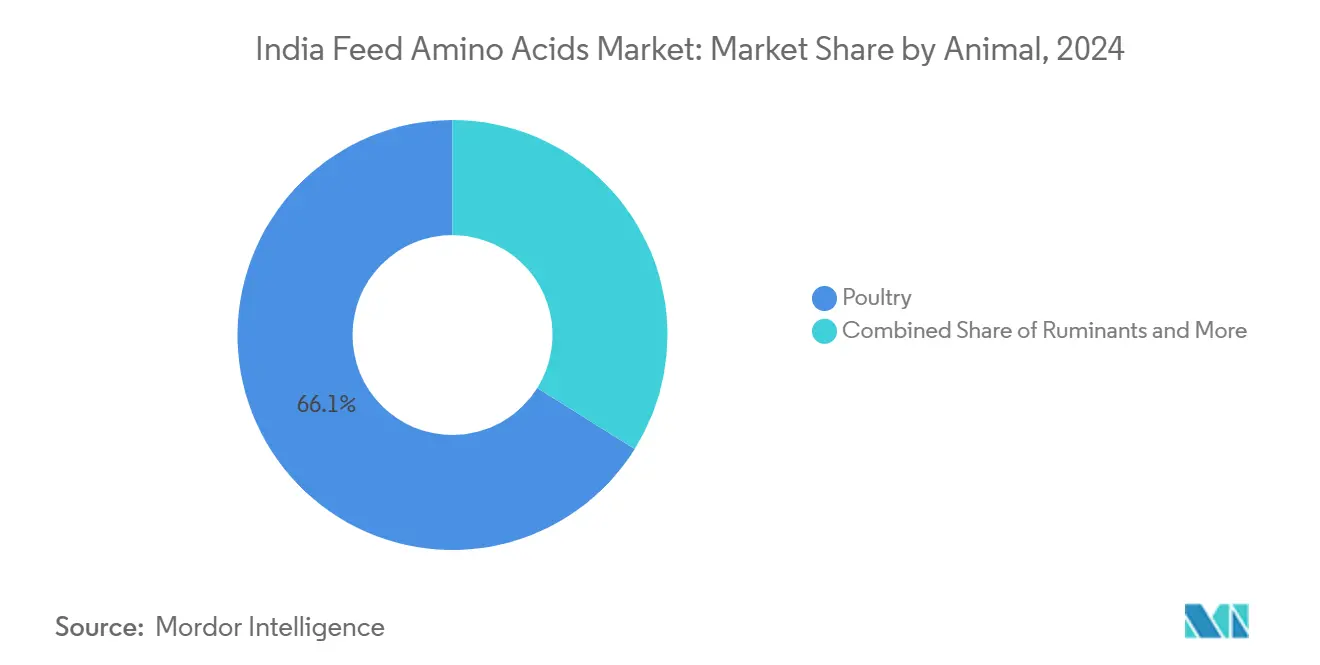
Note: Segment shares of all individual segments available upon report purchase
Geography Analysis
Regional production patterns reflect the concentration of livestock operations and feed manufacturing infrastructure across India's diverse agricultural landscape. Andhra Pradesh dominates aquaculture amino acid consumption, accounting for approximately 95% of shrimp processing capacity through 65 companies operating dedicated facilities. The state's integrated production model, where processors own hatcheries, feed mills, and farms, creates concentrated demand for specialized amino acid formulations.
Maharashtra, Tamil Nadu, and Karnataka represent major poultry production centers with established amino acid consumption patterns and growing domestic fermentation capabilities. Maharashtra's position as India's largest sugar producer creates opportunities for molasses-based lysine fermentation, with several projects under development to reduce import dependence. The state's industrial infrastructure and proximity to major ports support both domestic production and import operations. Tamil Nadu's diversified livestock sector, including significant poultry and dairy operations, provides stable demand across multiple amino acid categories. The state's technical education infrastructure supports feed industry development and nutritional innovation.
Northern states including Uttar Pradesh, Punjab, and Haryana are emerging as significant amino acid markets driven by dairy sector expansion and government support for livestock development. These regions' large agricultural base and growing feed manufacturing capacity create opportunities for amino acid suppliers targeting ruminant nutrition applications. West Bengal and Odisha represent growing aquaculture markets, though production remains smaller than southern states. The eastern region's focus on freshwater fish farming creates distinct amino acid requirements compared to marine shrimp operations. Regional variations in feed ingredient availability, particularly protein meals and energy sources, influence amino acid supplementation patterns and create opportunities for localized formulation strategies.
Competitive Landscape
The India feed amino acids market shows moderate concentration, with major players including Adisseo, Alltech, Inc., Archer Daniels Midland Co., Evonik Industries AG, and SHV (Nutreco NV). This market structure creates a competitive environment that balances economies of scale with opportunities for specialized players. The competitive landscape is evolving as domestic players like Rossari Biotech expand amino acid production capabilities, including in-house choline chloride manufacturing that strengthens their position in the animal health and nutrition segment.
Strategic partnerships and joint ventures are reshaping competitive dynamics, exemplified by the Zydus-Perfect Day collaboration to establish fermentation-based protein production in India, potentially disrupting traditional amino acid supply chains. Technology adoption and supply chain resilience are becoming key competitive differentiators as regulatory requirements tighten and customer demands evolve. Companies with local production capabilities or diversified sourcing strategies are better positioned to manage trade uncertainties, including potential anti-dumping duties on Chinese lysine imports that could affect 60-70% of India's lysine supply.
The market's moderate concentration creates opportunities for specialized players targeting niche applications such as organic production, welfare-focused formulations, and species-specific aquaculture nutrition. Emerging disruptors include biotechnology companies developing novel amino acid production methods and precision fermentation technologies that could reduce production costs and environmental impact.
India Feed Amino Acids Industry Leaders
-
Adisseo
-
Alltech Inc.
-
Evonik Industries AG
-
SHV (Nutreco NV)
-
Archer Daniels Midland Co.
- *Disclaimer: Major Players sorted in no particular order
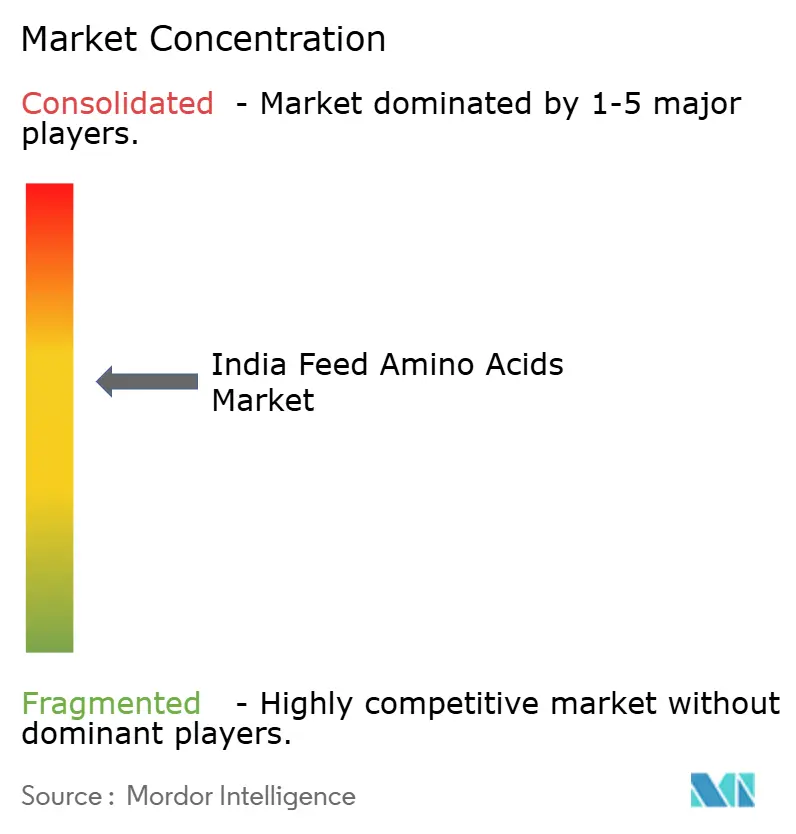
Recent Industry Developments
- August 2024: Zydus Lifesciences partnered with Perfect Day Inc. by acquiring a 50% stake in Sterling Biotech Ltd. to enter the precision-fermented, animal-free protein market. This collaboration will establish manufacturing facilities in India to produce proteins for global markets, aiming to capitalize on the growing demand for sustainable and animal-free nutrition and potentially disrupt traditional amino acid supply chains.
- June 2024: Camlin Fine Sciences subsidiary acquired 100% ownership of Vitafor Invest NV and its subsidiaries for EUR 1 (USD 1.07), expanding the Mumbai-headquartered company's animal nutrition portfolio across poultry, swine, ruminant, aquaculture, and pet food segments. The acquisition strengthens CFS's capabilities in feed safety, animal performance enhancement, and nutritional product development.
- September 2022: The partnership between Evonik and BASF allowed Evonik certain non-exclusive licensing rights to OpteinicsTM, a digital solution to improve comprehension and reduce the environmental impact of the animal protein and feed industries.
India Feed Amino Acids Market Report Scope
Lysine, Methionine, Threonine, Tryptophan are covered as segments by Sub Additive. Aquaculture, Poultry, Ruminants, Swine are covered as segments by Animal.| Lysine |
| Methionine |
| Threonine |
| Tryptophan |
| Other Amino Acids |
| Aquaculture | By Sub Animal | Fish |
| Shrimp | ||
| Other Aquaculture Species | ||
| Poultry | By Sub Animal | Broiler |
| Layer | ||
| Other Poultry Birds | ||
| Ruminants | By Sub Animal | Beef Cattle |
| Dairy Cattle | ||
| Other Ruminants | ||
| Swine | ||
| Other Animals |
| Sub Additive | Lysine | ||
| Methionine | |||
| Threonine | |||
| Tryptophan | |||
| Other Amino Acids | |||
| By Animal | Aquaculture | By Sub Animal | Fish |
| Shrimp | |||
| Other Aquaculture Species | |||
| Poultry | By Sub Animal | Broiler | |
| Layer | |||
| Other Poultry Birds | |||
| Ruminants | By Sub Animal | Beef Cattle | |
| Dairy Cattle | |||
| Other Ruminants | |||
| Swine | |||
| Other Animals | |||
Market Definition
- FUNCTIONS - For the study, feed additives are considered to be commercially manufactured products that are used to enhance characteristics such as weight gain, feed conversion ratio, and feed intake when fed in appropriate proportions.
- RESELLERS - Companies engaged in reselling feed additives without value addition have been excluded from the market scope, to avoid double counting.
- END CONSUMERS - Compound feed manufacturers are considered to be end-consumers in the market studied. The scope excludes farmers buying feed additives to be used directly as supplements or premixes.
- INTERNAL COMPANY CONSUMPTION - Companies engaged in the production of compound feed as well as the manufacturing of feed additives are part of the study. However, while estimating the market sizes, the internal consumption of feed additives by such companies has been excluded.
| Keyword | Definition |
|---|---|
| Feed additives | Feed additives are products used in animal nutrition for purposes of improving the quality of feed and the quality of food from animal origin, or to improve the animals’ performance and health. |
| Probiotics | Probiotics are microorganisms introduced into the body for their beneficial qualities. (It maintains or restores beneficial bacteria to the gut). |
| Antibiotics | Antibiotic is a drug that is specifically used to inhibit the growth of bacteria. |
| Prebiotics | A non-digestible food ingredient that promotes the growth of beneficial microorganisms in the intestines. |
| Antioxidants | Antioxidants are compounds that inhibit oxidation, a chemical reaction that produces free radicals. |
| Phytogenics | Phytogenics are a group of natural and non-antibiotic growth promoters derived from herbs, spices, essential oils, and oleoresins. |
| Vitamins | Vitamins are organic compounds, which are required for normal growth and maintenance of the body. |
| Metabolism | A chemical process that occurs within a living organism in order to maintain life. |
| Amino acids | Amino acids are the building blocks of proteins and play an important role in metabolic pathways. |
| Enzymes | Enzyme is a substance that acts as a catalyst to bring about a specific biochemical reaction. |
| Anti-microbial resistance | The ability of a microorganism to resist the effects of an antimicrobial agent. |
| Anti-microbial | Destroying or inhibiting the growth of microorganisms. |
| Osmotic balance | It is a process of maintaining salt and water balance across membranes within the body's fluids. |
| Bacteriocin | Bacteriocins are the toxins produced by bacteria to inhibit the growth of similar or closely related bacterial strains. |
| Biohydrogenation | It is a process that occurs in the rumen of an animal in which bacteria convert unsaturated fatty acids (USFA) to saturated fatty acids (SFA). |
| Oxidative rancidity | It is a reaction of fatty acids with oxygen, which generally causes unpleasant odors in animals. To prevent these, antioxidants were added. |
| Mycotoxicosis | Any condition or disease caused by fungal toxins, mainly due to contamination of animal feed with mycotoxins. |
| Mycotoxins | Mycotoxins are toxin compounds that are naturally produced by certain types of molds (fungi). |
| Feed Probiotics | Microbial feed supplements positively affect gastrointestinal microbial balance. |
| Probiotic yeast | Feed yeast (single-cell fungi) and other fungi used as probiotics. |
| Feed enzymes | They are used to supplement digestive enzymes in an animal’s stomach to break down food. Enzymes also ensure that meat and egg production is improved. |
| Mycotoxin detoxifiers | They are used to prevent fungal growth and to stop any harmful mold from being absorbed in the gut and blood. |
| Feed antibiotics | They are used both for the prevention and treatment of diseases but also for rapid growth and development. |
| Feed antioxidants | They are used to protect the deterioration of other feed nutrients in the feed such as fats, vitamins, pigments, and flavoring agents, thus providing nutrient security to the animals. |
| Feed phytogenics | Phytogenics are natural substances, added to livestock feed to promote growth, aid in digestion, and act as anti-microbial agents. |
| Feed vitamins | They are used to maintain the normal physiological function and normal growth and development of animals. |
| Feed flavors and sweetners | These flavors and sweeteners help to mask tastes and odors during changes in additives or medications and make them ideal for animal diets undergoing transition. |
| Feed acidifiers | Animal feed acidifiers are organic acids incorporated into the feed for nutritional or preservative purposes. Acidifiers enhance congestion and microbiological balance in the alimentary and digestive tracts of livestock. |
| Feed minerals | Feed minerals play an important role in the regular dietary requirements of animal feed. |
| Feed binders | Feed binders are the binding agents used in the manufacture of safe animal feed products. It enhances the taste of food and prolongs the storage period of the feed. |
| Key Terms | Abbreviation |
| LSDV | Lumpy Skin Disease Virus |
| ASF | African Swine Fever |
| GPA | Growth Promoter Antibiotics |
| NSP | Non-Starch Polysaccharides |
| PUFA | Polyunsaturated Fatty Acid |
| Afs | Aflatoxins |
| AGP | Antibiotic Growth Promoters |
| FAO | The Food And Agriculture Organization of the United Nations |
| USDA | The United States Department of Agriculture |
Research Methodology
Mordor Intelligence follows a four-step methodology in all our reports.
- Step-1: IDENTIFY KEY VARIABLES: In order to build a robust forecasting methodology, the variables and factors identified in Step-1 are tested against available historical market numbers. Through an iterative process, the variables required for market forecast are set and the model is built on the basis of these variables.
- Step-2: Build a Market Model: Market-size estimations for the forecast years are in nominal terms. Inflation is not a part of the pricing, and the average selling price (ASP) is kept constant throughout the forecast period.
- Step-3: Validate and Finalize: In this important step, all market numbers, variables and analyst calls are validated through an extensive network of primary research experts from the market studied. The respondents are selected across levels and functions to generate a holistic picture of the market studied.
- Step-4: Research Outputs: Syndicated Reports, Custom Consulting Assignments, Databases & Subscription Platforms
